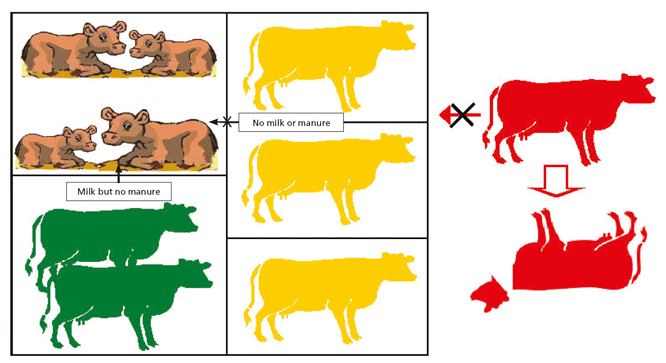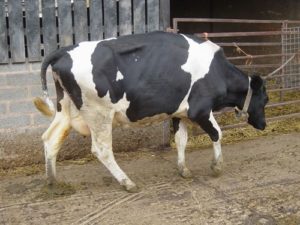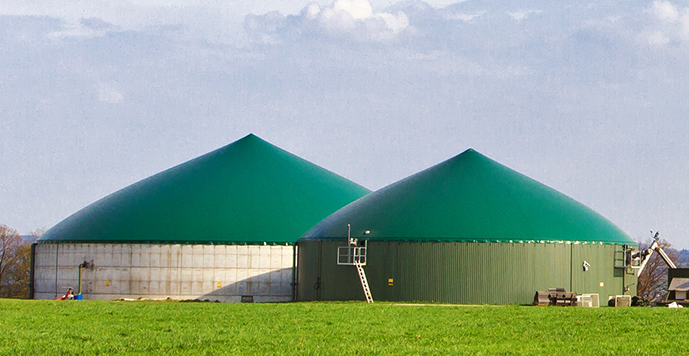WEBINAR ON THE UK JOHNE’S PROGRAM
2019-06-27 14:48:50New thinking on Johne's and Getting the best from your JD review - AHDB Dairy

Dr. Peter Orpin offers a webinar (published June 27, 2019) discussing how veterinarians and farmers can work together effectively to reduce the prevalence of Johne’s disease in their dairy herds using structured risk assessments, farm walks and 100% engagement in Johne's disease control using UK’s National Johne's Management Plan.
During this webinar Dr. Orpin, a veterinary practitioner in Leicestershire and one of the key experts involved in developing the control strategies for Action Johne’s covers:
- a review of the risks of transmissions and new thinking on disease progression within infected herds,
- advice on how we can effectively manage and create a clear plan of action for infected cows and
- how to generate a “green calving line and green calf line” to produce healthy productive low-risk JD replacements.
The control of Johne's Disease is a real challenge but one that can be tackled. The majority of dairy farms in Great Britain are now part of the National Johne's Management Plan and have adopted one of the 6 strategies for dealing with Johne's disease recommended by the Action Group of Johne’s.
You can access this one hour long webinar on You Tube (the first 40 minutes are a presentation and the remainder is Q&A).
Explanatory note: The UK program adopts the Danish system of classify cows based on ELISA testing of milk samples for antibody to MAP and the color code animals based on the results: “Red” cows are those that tested positive on the last 2 milk ELISAs, “Yellow” cows have fluctuating milk ELISA results, and “Green” cows are consistently negative by milk ELISA. The Red cows are considered in the most advanced stage of Johne’s disease and the most infectious, i.e. highest risk of spreading the infection on the farm.

Comment: The webinar is particularly good at describing why Johne’s disease control programs on dairy farms fail.
KILLING MAP IN DAIRY SLURRY
2019-06-24 19:39:23Research Article
A Chilean research team has published a study of how chemical treatments of manure and other wastes from dairy cattle, collectively called slurry, affect the viability of MAP as well as other bacterial organisms. The article appears in the Journal of Applied Microbiology and is authored by C. Avilez et al. from the Instituto de Medicina Preventiva Veterinaria, Universidad Austral de Chile, Valdivia, Chile.

Abstract
Aims: A major drawback of using dairy slurry as fertilizer is that it may contains pathogens such as Mycobacterium avium subsp. paratuberculosis (MAP), and it could represent a risk to animal and public health. Thus, the aim of this study was to evaluate the fate of MAP and bacterial communities in dairy slurry after chemical treatments.
Methods and Results: Cattle slurry, naturally contaminated with MAP, was collected from a dairy herd and divided into 32 glass bottles which were assigned to eight different treatments (control, 3.0% CaO, 0.5% NaOH; 0.087%, 0·11% and 0.14% H2SO4; and 1.0 and 2.5% KMnO4). Treated dairy slurry samples were evaluated at 0, 1, 3, 7, 15, 30 and 60‐days following treatment application for viable MAP and dairy slurry pH, and in addition temperature in this material was monitored continuously. Bacterial counts were estimated at each sampling time. A Bayesian zero‐inflated Poisson mixed model was fitted to assess the effect of each treatment on the count of MAP cells. Model results indicated that only the 3.0% CaO treatment had a statistically important negative effect on MAP counts during the study period. For most treatments, MAP was undetectable immediately after chemical treatment but re‐appeared over time, in some replicates at low concentrations. However, in those cases MAP counts were not statistically different than the control treatment. Regarding the fate of the other bacterial populations, the Firmicutes phylum was the dominant population in the un‐treated slurry while Clostridia class members were among the most prevalent bacteria after the application of most
Conclusion: Only 3% CaO treatment had a statistically important negative effect on MAP viability in cattle slurry.
Significance and Impact of the Study: This study provides evidence of MAP partial control in dairy slurry. This information should be considered as a best management practice to reduce MAP and other pathogens for slurry management on dairy farms. chemical treatments.
Comment: Unfortunately, this is not an Open Access publication. As indicated on the Wiley Online Library site, the article can be purchased for $7 for 24 hour access, $16.50 for read-only access, or $42 for the full text and PDF download.
LAMENESS LINKED TO JOHNE’S DISEASE
2019-06-20 14:30:17Research Article
 J. Smith and S. van Winden from the department of Pathobiology and Population Sciences, Royal Veterinary College, Hertfordshire, UK reported 10-June-2019 in the journal Animals a study on the association of lameness in dairy cattle with a diagnosis of Johne’s disease (JD) based on ELISA testing of milk samples (IDEXX kit).
J. Smith and S. van Winden from the department of Pathobiology and Population Sciences, Royal Veterinary College, Hertfordshire, UK reported 10-June-2019 in the journal Animals a study on the association of lameness in dairy cattle with a diagnosis of Johne’s disease (JD) based on ELISA testing of milk samples (IDEXX kit).
Findings: JD cows turn lame on average three months earlier and are lame 2.7 times more often than non-JD cows. Further, high-positive cows were 2.8 times more likely to develop lameness after JD diagnosis compared to medium-positive cows (referring to the magnitude of the ELISA result - further evidence of the importance of reporting ELISA results quantitatively). Results of this study suggest that there is a link between JD and lameness and that JD precedes lameness. The underlying mechanisms for this association remain unknown and were not the scope of this study.
This article is an open access article distributed under the terms and conditions of the Creative Commons Attribution (CC BY) license (http://creativecommons.org/licenses/by/4.0/).
Comment: To assess lameness in dairy cattle a scoring system was created and converted to an App by the faculty at the University of Wisconsin, School of Veterinary Medicine, department of Food Animal Production. Read more about the App and scoring system HERE.
MAP & PASTEURIZATION
2019-06-18 15:28:43REVIEW ARTICLE

An excellent review on MAP in milk and pasteurization was published 11-June-2019 in International Journal of Dairy Technology. The article is titled: Are we closer to understanding why viable cells of Mycobacterium avium subsp. paratuberculosis are still being reported in pasteurised milk? The author is W Michael A Mullan, UK researcher.
Abstract: Mycobacterium avium subsp. paratuberculosis (MAP) continues to be associated with Crohn’s disease. Following work in the 1990s that suggested that statutory pasteurisation of milk (72 °C, 15 s) was insufficient to destroy MAP, the UK Dairy Industry increased the holding time to 25 s. Since then, some plants have increased the lethality of pasteurisation further with a number using 78 °C for 27 s. Despite the increase in lethality, a recent survey of pasteurised milk in England found that 10.3% of pasteurised milk samples tested positive for viable MAP. This article discusses the significance of MAP and why viable MAP might be found in pasteurised milk.
This 13 page review nicely summarizes the state of understanding on MAP and pasteurization providing 7 tables and 66 references. It concludes with 8 possible explanations as to why MAP continues to be found live in retail HTST pasteurized milk. Normally, this is not an Open Access publication. As indicated on the Wiley Online Library site, the article can be purchased for $7 for 24 hour access, $16.50 for read-only access, or $42 for the full text and PDF download.
UPDATE: The publisher has agreed to make the article freely available, i.e. open access, for one month from today, June 18! Thank you Wiley Online!
Note: Please excuse the use of both the British and American spellings of pasteurization / pasteurization. Just trying to be fair :-)
REVIEW OF PARATUBERCULOSIS CONTROL PROGRAMS IN 48 COUNTRIES
2019-06-14 14:52:55REVIEW ARTICLE
BMC Veterinary Research 2019 15:198 published 13-June-2019

Dr. Richard Whittington, Emeritus Professor, School of Veterinary Science, Faculty of Science, University of Sydney led an international team to formally summarize paratuberculosis control programs across the world. This Open Access review involved 76 coauthors from 48 countries. The final report in BMC Veterinary Research contains 29 pages with 14 tables and 3 figures and 168 references. Supplementary information, including the questionnaire used in the survey, is provided in 5 additional files.
Conclusions stated at the end of the review:
Based on this review of 48 countries, paratuberculosis was a common disease that will continue to spread if it is not controlled. However, there were many challenges for disease control flowing from the need to deal with very large animal populations spread across large numbers of herds, over a long time-frame. Many countries have an unknown prevalence and distribution of paratuberculosis, which can only be resolved by surveillance. Although we did not estimate the economic losses, based on data in the literature (see Background) they would already be considerable. Formal control programs were underway in 22 mostly developed countries, and were justified most commonly on animal health grounds, protecting market access and public health. However, articulation of a public health objective was very variable between countries. The most common objective was prevalence reduction, but several countries had a national or regional eradication program following successful control, and Sweden and Norway were considered to be in a surveillance phase. While control was voluntary in 60% of countries, programs were often supported by incentives and/or penalties for non-participation. Government funding was commonly involved and may be essential for sustainability; certainly, the availability of funding for long-term control activities was problematical. However, when assessed against their objectives, control programs were reported to be successful in 73% of 22 countries.
To enhance the control of paratuberculosis globally will require leadership, commencing with an agreed international code for paratuberculosis, describing the principles and methods of control. All ruminant livestock industries must be involved to prevent one industry becoming a reservoir of MAP for another industry. Public health assessments of MAP between countries also require an unbiassed harmonisation. Paratuberculosis detection and control will be improved through research on improved diagnostic tests and epidemiology. Vaccination against paratuberculosis, and the competing objectives of bovine tuberculosis and paratuberculosis control that exist because of use of the skin test for bovine tuberculosis surveillance, require re-evaluation. There are winners and losers in any control program, and for this reason all stakeholders must be educated about long-term goals and benefits in order to create a mutually supportive environment to allow for control of paratuberculosis.
Comment: This review represents and enormous amount of work and while there are many coauthors on this publication who contributed to this project, most of the work was done by the lead author, Dr. Whittington, who deserves a big vote of thanks for advancing international efforts to control paratuberculosis.
LAMBING AFFECTS PCR RESULTS IN SHEEP WITH SUBCLINICAL PARATUBERCULOSIS
2019-06-12 20:22:28 Mataragka et al. from the Agriculture University of Athens and Kapodestrian University of Athens (Greece) reported intriguing findings regarding paratuberculosis in sheep. Their novel study explored the effects of parturition (lambing) on detection of MAP infections using IS900 real-time PCR. The study was done in a single flock of sheep that had a history of many animals testing positive for MAP infections by culture or PCR. All animals deemed pregnant were enrolled in the study. Feces was collected from animals at 5 different time periods: 4–15 and 1–3 days before lambing (FP1/FP2), immediately before and 4-15 days after lambing (FP3/FP4), and before mating roughly 6-7 months later (FP5).
Mataragka et al. from the Agriculture University of Athens and Kapodestrian University of Athens (Greece) reported intriguing findings regarding paratuberculosis in sheep. Their novel study explored the effects of parturition (lambing) on detection of MAP infections using IS900 real-time PCR. The study was done in a single flock of sheep that had a history of many animals testing positive for MAP infections by culture or PCR. All animals deemed pregnant were enrolled in the study. Feces was collected from animals at 5 different time periods: 4–15 and 1–3 days before lambing (FP1/FP2), immediately before and 4-15 days after lambing (FP3/FP4), and before mating roughly 6-7 months later (FP5).
The results demonstrated significant differences in rate of PCR positivity based on sampling time: FP1 = 38.3% (23/60), FP2 = 38.3% (31/81), FP3 = 34.1% (29/85), FP4 = 40% (34/85), and FP5 = 21.3% (16/75). The proportion of the animals that reacted positively to real time PCR at one, two, three or four sampling periods was 47.1% (33/70), 27.1% (19/70), 15.7% (11/70), and 8.6% (6/70) of the positive reactors, respectively. Animals testing PCR-positive at more than one sample collection had lower Ct values (indicative of higher levels of MAP shedding in feces) than animals testing PCR-positive only one time. Interestingly, only one sheep was IS900-PCR-positive at all five sample collections (FP1-5) corresponding to 1.4% (1/70) of PCR reactors. Interestingly, this was the only sheep that tested positive by ELISA (IDEXX laboratories). It was a 3-year old ewe and clearly in the most advanced stages of a MAP infection.
In conclusion, when testing sheep with subclinical paratuberculosis, the period of 4–15 days postpartum is the best time to test for paratuberculosis using IS900 real-time PCR. The use of ELISA is not recommended due to its low diagnostic sensitivity.
Take-home messages:
1. Real-time IS900-PCR is far superior to ELISA (blood tests) for paratuberculosis in sheep.
2. Testing fecal samples collected 4-15 days after lambing provides somewhat greater diagnostic sensitivity (ability to detect MAP-infected animals).
3. Testing a single fecal sample, regardless of time relative to lambing, will not detect all MAP-infected animals. Thus, testing annually is recommended.
Comment: Testing multiple fecal samples from an individual will likely increase diagnostic sensitivity even more than the timing of the collection of a single sample relative to lambing. Zoological institutions in the U.S. when testing individual animals for paratuberculosis are commonly collecting fecal samples on 3 different days and then having the laboratory test a pool of these samples by real-time PCR as a means of enhancing the ability to detect MAP-infected animals.
MAP SURVIVAL IN ON-FARM BIOGAS PLANTS
2019-06-04 18:42:28Research Article:
Reduction of Viable Mycobacterium avium ssp. paratuberculosis in slurry subjected to anaerobic digestion in biogas plants. K Donat et al. Journal of Dairy Science, accessible online 15-MAY-2019.
 In Germany, a growing proportion of dairy farms run on-site biogas plants. New legislation on renewable energies has accelerated this development over the past two decades. Slurry or manure from cattle was fermented in 168 of 230 biogas plants in the region of Thuringia in the central part of the country.
In Germany, a growing proportion of dairy farms run on-site biogas plants. New legislation on renewable energies has accelerated this development over the past two decades. Slurry or manure from cattle was fermented in 168 of 230 biogas plants in the region of Thuringia in the central part of the country.
Abstract: Cattle infected with Mycobacterium avium ssp. paratuberculosis (MAP) shed the bacterium in their feces. This may lead to considerable concentrations of MAP in slurry, which has been postulated to contribute to MAP transmission when this slurry is used as fertilizer. For other bacterial species, anaerobic digestion has been shown to reduce bacterial load and to increase the safety of organic waste. Therefore, the objective of this study was to investigate the effects of anaerobic digestion in biogas plants on MAP survival in slurry from 16 dairy farms with a history of MAP infection.
Presence of MAP was determined using MAP culture and a commercial MAP IS900 quantitative PCR (qPCR) applied on untreated slurry samples, slurry samples after primary fermentation, and digestate. Unfermented slurry samples from most enrolled farms tested positive for MAP, via both culture and qPCR. After the fermentation process, MAP could no longer be cultured in most samples, with the exception of 2 samples from farms where high numbers of MAP-shedding cows were kept at the time of sampling. A Bayesian binomial model predicted a probability of 93% for a MAP-negative culture result after fermentation. In most samples, MAP DNA was still detectable when using the IS900 qPCR. The probability of a negative result in qPCR was estimated to be 27%. Results of this study indicate that subjecting MAP-positive slurry to anaerobic digestion in biogas plants leads to a reduction of viable MAP below the detection limit; however, MAP DNA remained detectable. It remains undetermined whether MAP DNA detected in fermentation products is a residue of MAP degradation or belongs to viable MAP below the detection limit or in a dormant state.
In conclusion, subjecting MAP-positive slurry to anaerobic mesophilic digestion reduces viable MAP concentration below the detection limit. The use of digestion products as fertilizer on pasture and agricultural soils instead of untreated slurry may therefore reduce the risk of MAP transmission.

Comment: The strength of this study is that is used real world conditions: Manure came from farms with MAP-infected animals, commercial on-farm biogas plants, and results represent the results compiled from 16 different plants making it the largest study of this type. A study limitation, as acknowledged by the study authors, is that traditional solid-medium culture methods were used to test for viable MAP. Such methods typically have a lower limit of detection of roughly 100 MAP/gram of test material, i.e. if fewer live MAP were in the sample tested they would not be detected, and the culture methods did not incorporate a resuscitation step to revive any dormant or spore-like forms of MAP.
This is an excellent article but is not an Open Access article. For more on what Open Access means and the growing trend to publish scientific articles as Open Access, follow this link to Wikipedia.
HOW MAP GETS INTO WATER
2019-05-27 20:01:14A UK team of scientists from Lancaster University, monitored the presence of MAP in the River Tywi catchment for a 10-year period. Their findings were published in the open access journal Microorganisms (volume 7, issue 5, May 15, 2019). Readers interested in the environmental distribution of MAP and modes of human exposure should definitely take a look at this novel study: 15 pages with 65 references. The figure below from this publication places rivers, lakes and reservoirs at the center of a complex model of MAP transmission.

Comment: More about MAP in food and water can be found at this location in our website. Human to human MAP transmission is a potential mode of human infection as shown in the publication from this research team. However, based on the rate of infection of animal populations and the volume of potentially MAP-contaminated feces they deposit in the environment day after day, the most efficient means of human MAP exposure control is resides on farms where producers and veterinarians have all of the necessary knowledge and diagnostic tools to control this infection.
HOW MAP GETS INTO MILK
2019-05-20 18:41:41
Contamination of bulk tank milk MAP can occur through direct shedding into milk by MAP-infected cows, fecal contamination, or introduction of soil and water containing MAP. Humans can be exposed to MAP and many other zoonotic pathogens via raw milk consumption. Additionally, MAP has been shown to survive pasteurization and has been found live at low levels in retail HTST pasteurized milk.
S. Rani, and colleagues reported a computer simulation model to evaluate factors affecting how many MAP bacteria get into milk. Their findings were published in the journal Food Control (vol. 104: 367-376, October 2019). Specifically, they assessed the influence of common hygiene practices, such as washing of udders before milking and the use of milk filters, on the concentration of MAP in bulk tank milk. Their baseline model comprising all hygiene practices on a farm provided an average estimate of 0.76 log CFU/L (at least 5 MAP cells per liter) for the final concentration of MAP in bulk tank milk, with a maximum of 6.70 log CFU/L (over 5 million MAP cells per liter) and a minimum of 0.04 log CFU/L (~1 MAP cell per liter) depending on herd size and the ratio of infection statuses among cows in the herd.
In this model, the average level of fecal contamination of milk in a herd showed the greatest impact on the final MAP concentration per liter in bulk tank milk. In simple terms, hygienic practices at the time of milking the cow is the most important tool to limit MAP contamination of raw milk.
Comment: This conclusion that fecal contamination is the most important means by which MAP gets into raw milk are similar to those of an earlier model published by Nauta & Van der Giessen in the Veterinary record in 1998 (Vet. Rec. 143:293-296). Nauta & Van der Giessen found that the number of cows with clinical Johne’s disease in a herd also was important in estimating the number of MAP in milk. In a related study, Vissers et al. (J. Dairy Sci. 90:3579-3582) evaluated how much dirt (feces, soil and bedding) is found in milk by testing 11 Dutch dairy herds. They reported that the amounts varied widely among farms ranging from 0.7 mg “dirt”/liter of milk to 136 mg “dirt”/ liter of milk with an overall average of 0.59 mg/L.
If MAP-infected dairy herds can eliminate the cows that are heavy shedders of MAP and also maximize the hygiene at the time of milk collection, the raw milk will contain the minimum number of MAP giving pasteurization the best possible chance of killing off those few remaining MAP bacteria. Consumers of raw milk should assume they are consuming MAP unless the herds used as a milk source are 100% test negative for Johne’s disease over multiple years using the most sensitive diagnostic tests, i.e. direct PCR on fecal samples.
To learn more about MAP's ability to resist killing by pasteurization, check out this page on our site under the heading "Biology of MAP"/Resistance.
MAP SURVIVES TEEWURST DURING SAUSAGE PRODUCTION
2019-05-01 13:54:47 Teewurst is a traditional raw spreadable sausage of German origin that can be prepared from pork, beef as well as poultry meat. It has a short ripening process (1–5 days) at high humidity and relatively high moisture content. Even if no additional sugar and starter cultures are added, the final pH value drops below 5.2 which should ensure microbiological safety of the product. However, the results of a study (in press) reported by Alena Lorencova et al. from the Food and Feed Safety Department, Veterinary Research Institute, Brno, Czech Republic in the journal Meat Science demonstrated that the production process was not effective at inactivating MAP. Despite a significant decline during storage, viable MAP cells were present in teewurst for up to 4 weeks after production.
Teewurst is a traditional raw spreadable sausage of German origin that can be prepared from pork, beef as well as poultry meat. It has a short ripening process (1–5 days) at high humidity and relatively high moisture content. Even if no additional sugar and starter cultures are added, the final pH value drops below 5.2 which should ensure microbiological safety of the product. However, the results of a study (in press) reported by Alena Lorencova et al. from the Food and Feed Safety Department, Veterinary Research Institute, Brno, Czech Republic in the journal Meat Science demonstrated that the production process was not effective at inactivating MAP. Despite a significant decline during storage, viable MAP cells were present in teewurst for up to 4 weeks after production.
In contrast to teewurst, no viable MAP were recovered during the dry fermented sausage production process. The effect of starter culture (Lactobacillus sp. and Staphylococcus sp.), and lower moisture content, may have played roles in the inhibition of MAP. Starter cultures are necessary for fermentation and contribute to the sausage acidification and color and flavor development.
For more on the many kinds of sausages available worldwide, visit Wikipedia.
Comment: This study was NOT a survey of retail sausages. Rather, it was a laboratory experiment using MAP-spiked meat to prepare sausage and study MAP survival. The study yet again proves that MAP is very hardy. It does not indicate that MAP is in retail teewurst. Prior publications from this research team have documented MAP DNA in retail sausages but found no viable MAP using culture methods.
« Previous 1 … 13 14 15 16 17 18 Next »